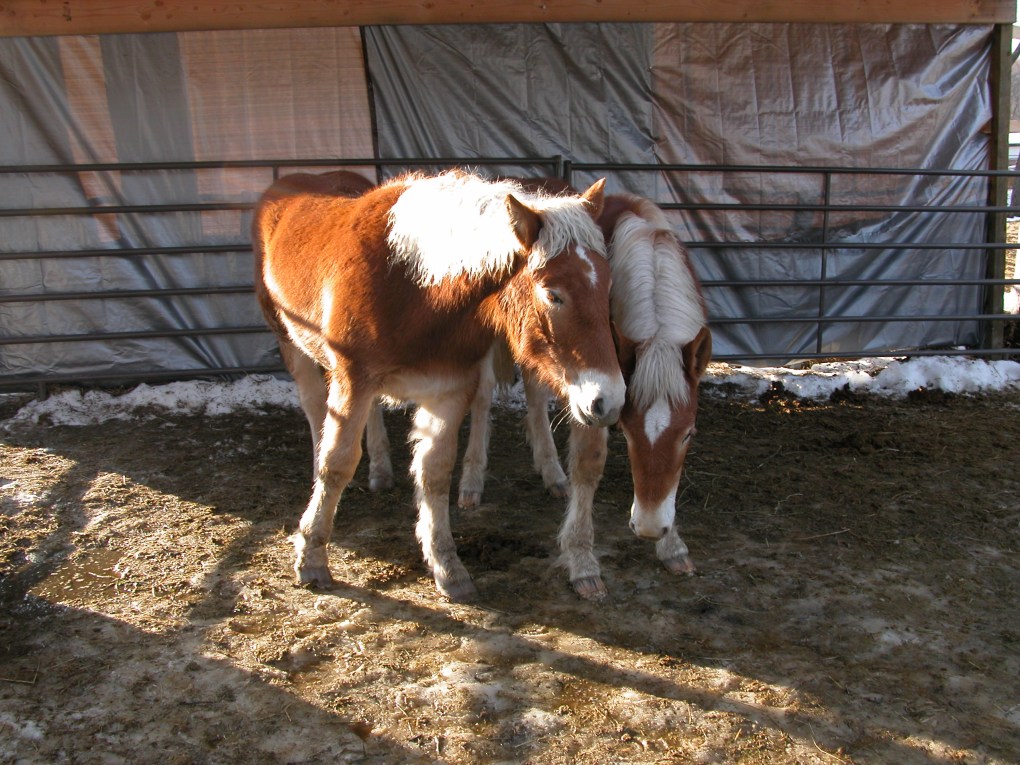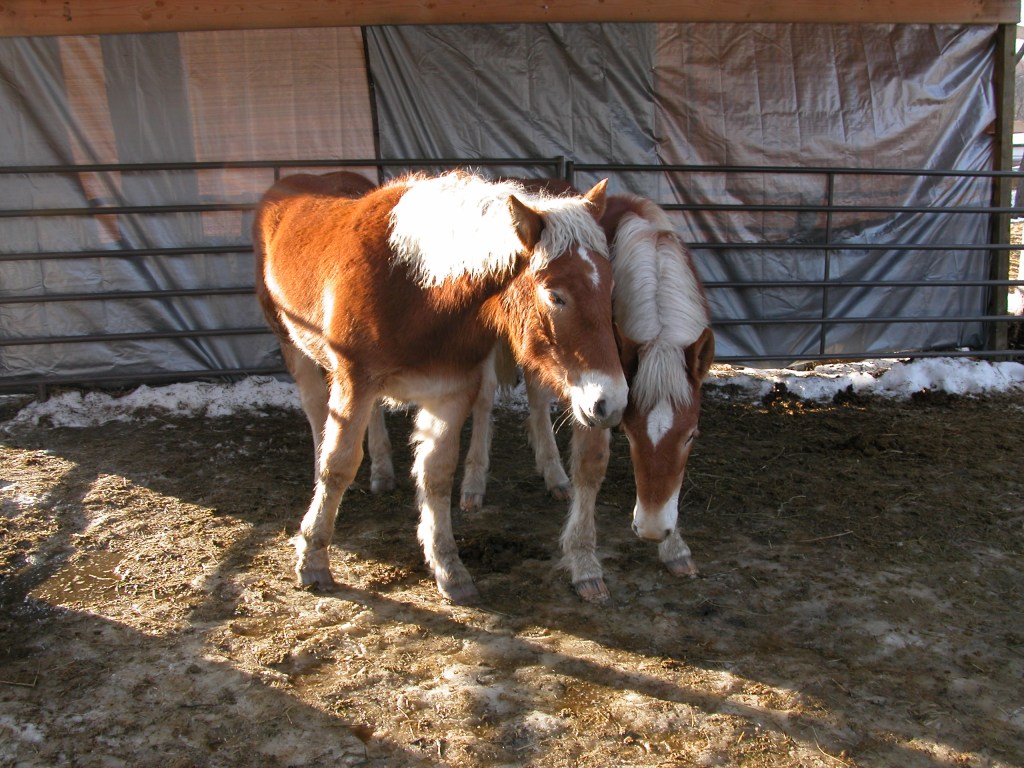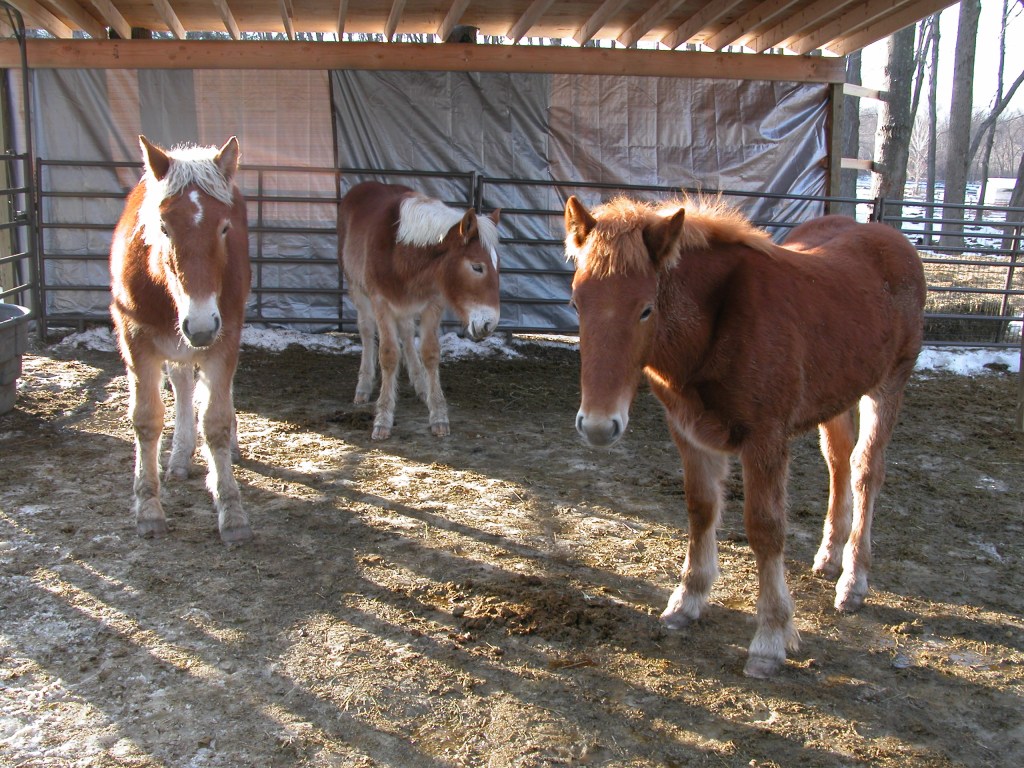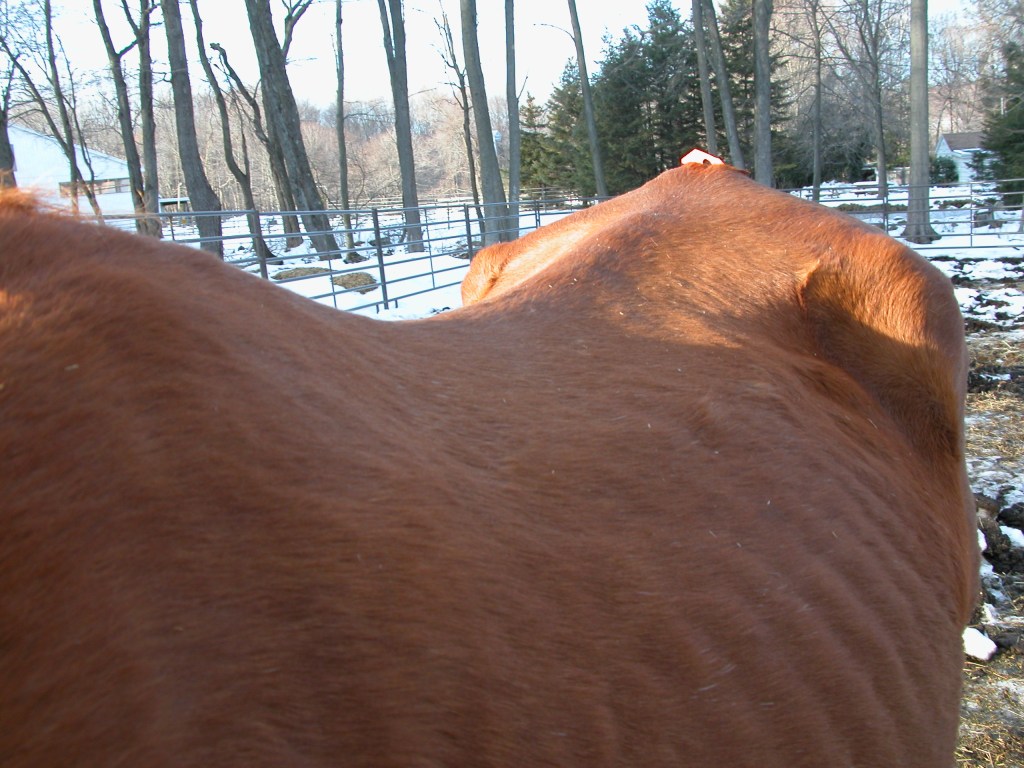On Locket’s Meadow we have a sweet mare named Mary . . . Mary Catherine, to be precise, but when I think about her she is always Melancholy Mary to me. She’s never quite sad, never quite happy . . . she’s just . . . Mary. She’s a good girl, seldom difficult. And always in her own world, just a little distant from the rest of us.
My memory for dates isn’t great but it was about 2004 when we received a trailer load of horses from a ranch in Alberta, Canada. I remember it was cold that day, and the water troughs were frozen around the edges despite the stock tank heaters. I’d learned about the ranch these horses came from at the end of the previous summer. The owner had died, leaving his wife with around 90 Suffolk Punch drafts and draft crosses that he used in the PMU (pregnant mare urine) industry. Ranchers collected the urine from the pregnant mares, which was used in manufacturing hormone replacement therapy drugs such as Premarin and Prempro, but much more about that later. The rancher’s wife’s name is burned into my memory, never to be forgotten, but I won’t mention it here. She had decided to get rid of all the horses the easiest way, which was to load them onto trailers and send them to slaughter. The horse rescue world found out and scrambled to try to save them. Suffolk punches are actually rather rare (which shouldn’t matter as a horse is a horse and all of them matter,) but for some, it’s a motivating factor. Most of the purebreds went to a ranch in Texas, while we dredged up money enough to rescue four crossbred mares and three foals and sent our check north with a plan to get them trailered down within a few weeks.
Alberta is a tricky place as weather goes, and the first blizzard hit early in September, followed by another, and another . . . there were no haulers who could fight their way through to pick up a bunch of wild horses and bring them to Connecticut. I learned that their owner, who had no interest in them at all, had put them out in a winter pasture and left them there. I imagined she was throwing them hay, or something . . .
It was early January when I finally found a hauler who would bring them to Connecticut, as there had been a thaw. I could find no references on him, but I had to take the chance, as there had been no other takers for the job. He arrived with our rescues mid-month and backed the trailer up to the quarantine paddock next to our driveway. When he opened the rear doors the horses barreled out one at a time, attacking the water troughs and piles of hay as if they had not seen any in a month. Turns out it may have been longer than that.
The first two mares were shaggy black Suffolk crosses. Their hipbones poked from beneath their enormous, fluffy coats. I knew one was named Burnt Candy, but the other arrived nameless. The third mare was chestnut. She was so emaciated you could count the ribs beneath her woolly coat. That was Cinnamon. The fourth mare, a gorgeous deep-red chestnut cross, was in slightly better shape than the black mares, but still thin. The three foals who barreled out last were beautiful. The first was the same deep chestnut as Cinnamon, and turned out to be her son; we named him Chili. The next two looked almost like twins, both a light chestnut with white manes and tails, the only difference between them being different white markings on their foreheads.
I wondered how these three could look so much healthier than the mares, who I now realized had been subsisting by pawing through the deep snow for scraps of grass. I quickly learned how they had thrived as I watched one foal after another nurse from Cinnamon, and I understood why she was so skinny. That sweet angel had sacrificed her own health to take care of all the babies. She was my new hero.
Eventually I will write about some of the other horses, but this memory is about “the twins,” as we called them, who were inseparable. We named one Mary Catherine, who had an S-shaped mark on her forehead, and the other Catherine Mary, or Kitty. Her forehead was graced with a white star, and they were always side-by-side. Chili was the adventurous one, always off causing trouble and instigating, but not the twins. They were sweet, calm and always peaceful. They stayed near the adult mares and watched Chili as he made his irritating rounds. Eventually he’d find his way to them and they would turn their backs and stand pressed together, a united “rear,” so to speak. He nipped at their rumps, so much like a little boy on the playground yanking on the girls’ braids, with the girls muttering, “stupid boys” under their breath. Besties for life.
When we get new rescues we keep them strictly quarantined for at least two weeks, or if they develop any illness, much longer. Only a few people are allowed to enter the paddock, and they change their clothes and scrub before going near any other animals. There’s a pan of bleach near the gate to step in on the way out to sanitized boots, and the horses are carefully watched for signs of illness. Primarily we are looking for strangles, a strep-like disease that affects the upper respiratory system and causes lymph nodes to swell to the point of bursting and oozing puss. It’s highly contagious among horses, seriously gross and quite common in Canada. We had never seen it before on our farm, but there could always be a first time.
It was exactly 10 days after the Suffolks’ arrival that I got a message from one of my northern contacts that strangles had been diagnosed on the farm belonging to the hauler who had transported the horses. It was exactly 11 days after their arrival that all of the babies developed strands of mucous pouring from their noses. The hauler had clearly not disinfected his trailer before he loaded our horses and they had become infected. I have strings of adjectives for him I’d like to list right here, but I will resist . . . for now . . .
Here’s the thing about strangles – it’s highly contagious but seldom deadly, unless a horse contracts the “bastardized” version of it. In that case, it doesn’t focus only on the upper respiratory, but can pop up anywhere in the body. Bastard strangles only affects one percent of the animals who contract the disease, but it’s almost always fatal, and there’s no way to tell if a horse has it . . . until they die. The adults, being from Canada, were immune, as they’d most likely had it in their youth. Canadians treat it as we used to see chicken pox, kind of a get-it-over-with disease they get once and don’t catch again. We vaccinate for strangles in the USA, particularly horses that travel or compete.
Within days, all three babies were desperately ill. None of them could eat, all had fevers and were despondent, and soon, the three of them were oozing puss from glands beneath their jaws. I was frantic, to say the least. I tried every trick I could think of to get fluids and food into them, and for Mary and Chili I managed to make some progress, but Kitty . . . Kitty got sicker and more depressed by the hour. I was on the phone with the vet several time a day, looking for anything that could help her, but nothing worked. I began to believe we were dealing with something worse, but I couldn’t bring myself to say it.
By day five, I was terrified. Mary and Chili were turning the corner and nibbling on warm mash and bits of hay, but Kitty . . . not Kitty. That afternoon she was holding herself up by leaning her chin on the fence and bracing all four legs. She was fighting the urge to lie down with every fiber of her being, and I could smell something toxic and rotten on her breath. And I knew. I absolutely knew that the worst possible scenario for strangles was playing out in my own backyard. All of the other horses crowded around her, so protective, and Mary pressed against her hind end, helping her to stay standing.
I wrapped my arms around her neck and hugged her gently. We had brought more than a hundred rescued horses through the farm at that point, and had never lost a single one, no matter what was wrong with them. Poor Kitty was clearly suffering, and it was devastating. I could have the vet come out and euthanize her, but the thing about strangles is, you don’t know if they’re going to die until they actually do, so there was always the slightest chance and you had to wait it out . . . perhaps this was just a harsher case of strangles than the others had . . .
Kitty wobbled on all four legs, but refused to lie down. I tried to tell her it was OK, she could do what she had to, but she stood stoically, chin pressed on the top rail of the fence. I realized she was trying to not die in front of me.
“Please, Kitty. Let me stay with you. I’ll be OK,” I said.
She pressed her chin more firmly into the fence rail. I felt that she didn’t think I could handle it, and it was best if I left. OK, I could understand that because I was sobbing uncontrollably, and I would have stopped crying if I could, but that wasn’t gonna happen. It was a standoff between foal and her adoptive mama, and I finally decided I was being cruel by remaining there. I went into the house and joined my husband, who had known he couldn’t watch it much earlier.
It was maybe two minutes before I decided to go back out. I was never one to leave my babies when they were leaving me, and I couldn’t do it then. I raced out the back door to the paddock, where Kitty had finally laid down on the bed of straw inside the shed, surrounded by her horse family. I sat in front of her and she lifted her head and placed it on my lap. I stroked her face for the next few minutes, thinking how I needed to be present right there, in that moment, because it was all I had left with her. Her breathing grew more and more shallow, and then . . . it stopped. I sat on the cold ground, sobbing, holding Kitty’s beautiful face, surrounded by the other horses who stood with their noses low to the ground. That’s when I let loose with the torrent of adjectives for the negligent driver who had murdered our sweet pony, knowing there was nothing I could do about it.
We buried her at the top of the hill in our backyard, no marker, but if you want to know where she is I could walk you right up and stand over her grave. She left behind a circle of shattered family, both horse and human, none more so than her sister Mary, who was lost without her BFF. As I write this, 15 years have passed, and Mary, who had been so happy and bright eyes within days of her arrival at Locket’s Meadow, is still melancholy, still missing her sister. All the hope and promise of their rescue was laid to rest at the top of that hill, and while the others recovered, Mary still mourns.
I blame myself for using a hauler I didn’t know, but at that point, all of their lives were in jeopardy if I didn’t get them out of Alberta. There’s no telling how long the window of good weather would have lasted (it didn’t,) and there was not a single other hauler interested in taking the job. I did the best I could with what information I had, and I will always feel I failed Kitty and Mary, despite my best efforts.
Every day I walk Mary up to her paddock and I feel her melancholy and I understand why. Every single day she and I think about Kitty as I bring her up the hill, and I know she takes comfort in the fact that I remember her sister, as well, and in our combined memories she will live on as long as we do. It’s a ritual we will play out for the rest of our lives together.
Kitty’s tarot card is The Star, which stands for hope, faith, purpose, renewal and spirituality. After we lost her, we continued to rescue dozens of PMU mares and their foals for several more years. I had never been afraid of losing a rescue until Kitty, but I had to believe that what we were doing was the right thing, and that the horses we were saving from slaughter were worth the possible pain of losing yet another.
When people tell me they wish they lived our lives, I shake my head and tell them it’s not for most people, and there are days that it’s not even for me. Yet they see the relationship I have with all my babies and it looks amazing, and truly, it is. We love each other with a vengeance. But when we lose, and it’s always going to happen, the pain never gets easier, no matter how often you endure it.
As one of our vets, Dr. Stacey Golub, always says . . . the day it doesn’t bother you is the day you need to get out of the business. I know she is right.
There are a lot of keyboard warriors out there pontificating about how animals should be treated or cared for, and we are frequently the targets of their judgment. The world of rescue and sanctuary is a very black and white place for them, with a single set of specific rules. I often say there’s a huge difference between those who judge from their kitchen tables and those who are in the trenches of animal rescue, up to our knees in mud, crawling on the ground with our sick and downed babies, making life-and-death decisions on the fly.
Of course I look back and second guess my decisions; had I waited for a reputable hauler, would they all have survived until I could get another trailer up there? Cinnamon may not have. These are the questions I will ask myself for the rest of my life, doubts and self-flagellation that few people will never have to address. But when the burden of responsibility gets too heavy, the animals talk me down and somehow we go on, early to bed, early to rise, walk Mary up the hill yet one more time and remember beautiful Kitty along with her.
Not all of the picnic basket stories are as sad as Kitty’s. The next one is about Candy (we dropped the “Burnt” right away) and how she beat the odds and cheated death many more times after she got here. Lazarus had nothing on our sweet, old Candy. You will like her.




